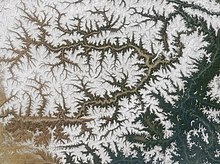
Back Yarlung Tsangpo Canyon Afrikaans यारलुंग त्सां पो गॉर्ज Bihari Dihangschluchten German Gran Cañón Yarlung Tsangpo Spanish Canyon du Yarlung Tsangpo French यरलुंग त्संगपो महान घाटी Hindi Ngarai Yarlung Tsangpo ID Gola dello Yarlung Tsangpo Italian Jarlungo Upės didysis kanjonas Lithuanian സാങ്പോ ഗിരികന്ദരം Malayalam



The Yarlung Tsangpo Grand Canyon, also known as the Yarlung Zangbo Grand Canyon, the Tsangpo Canyon, the Brahmaputra Canyon or the Tsangpo Gorge (simplified Chinese: 雅鲁藏布大峡谷; traditional Chinese: 雅魯藏布大峽谷; pinyin: Yǎlǔzàngbù Dàxiágǔ'), is a canyon along the Yarlung Tsangpo River in Tibet Autonomous Region, China. It is the deepest canyon in the world,[1][a] and at 504.6 kilometres (313.5 mi) is slightly longer than the Grand Canyon in the United States, making it one of the world's largest.[1][3] The Yarlung Tsangpo (Tibetan name for the upper course of the Brahmaputra) originates near Mount Kailash and runs east for about 1,700 kilometres (1,100 mi), draining a northern section of the Himalayas before it enters the gorge just downstream of Pei, Tibet, near the settlement of Zhibe. The canyon has a length of about 240 kilometres (150 mi) as the gorge bends around Mount Namcha Barwa (7,782 metres or 25,531 feet) and cuts its way through the eastern Himalayas. Its waters drop from about 2,900 metres (9,500 ft) near Pei to about 1,500 metres (4,900 ft) at the end of the Upper Gorge where the Po Tsangpo River enters. The river continues through the Lower Gorge to the Indian border at an elevation of 660 metres (2,170 ft). The river then enters Arunachal Pradesh and eventually becomes the Brahmaputra.[4][5]
- ^ a b Canyon, National Geographic Encyclopedic Entry, retrieved 15 July 2021.
- ^ Andrea Thompson, What's the Deepest Canyon?, livescience.com, 14 January 2013.
- ^ "The length, depth and slope-deflection of the great canyon are all the mosts of the world". www.kepu.net.cn. Retrieved 23 April 2018.
- ^ Yang Qinye and Zheng Du (2004). Tibetan Geography. China Intercontinental Press. pp. 30–31. ISBN 978-7-5085-0665-4.
- ^ Zheng Du, Zhang Qingsong, Wu Shaohong: Mountain Geoecology and Sustainable Development of the Tibetan Plateau (Kluwer 2000), ISBN 0-7923-6688-3, p. 312;
Cite error: There are <ref group=lower-alpha> tags or {{efn}} templates on this page, but the references will not show without a {{reflist|group=lower-alpha}} template or {{notelist}} template (see the help page).
© MMXXIII Rich X Search. We shall prevail. All rights reserved. Rich X Search